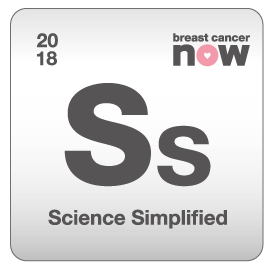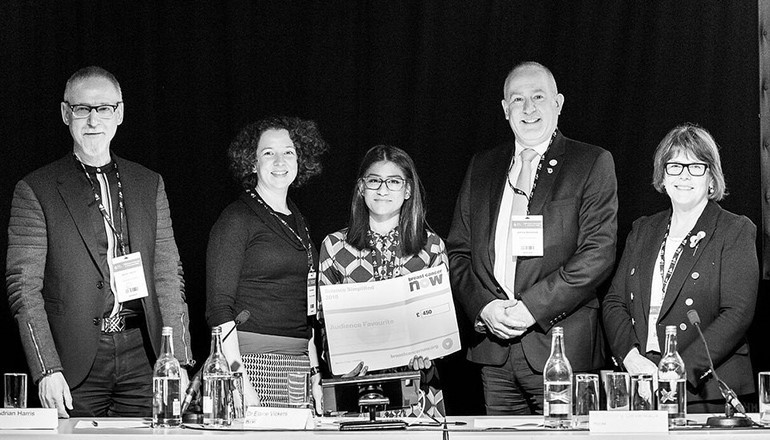Have you ever watched a television programme or read a news article about a scientific breakthrough and been left scratching your head, more confused than when you started?
This scenario is unfortunately all too common. Explaining scientific concepts and research that is highly technical in an accessible way is a difficult task. But it is an essential one.
At Breast Cancer Now, we want our researchers to be able to explain their research effectively, so our incredible supporters can be aware of the exceptional breast cancer research we fund. But not just with our funded research: we also want them to be aware of what’s happening beyond breast cancer research, including exciting advancements in other cancer areas.
Every year a few members of Breast Cancer Now’s research team attend a scientific conference hosted by the National Cancer Research Institute (NCRI).
This year, we wanted to do something a bit different by challenging researchers to describe their projects in simple, easy-to-understand terms – we called it “Science Simplified”.
You have three minutes

The challenge was simple – scientists had three minutes or less to describe their projects in language anyone could understand using only one PowerPoint presentation slide. Simplicity can be deceivingly difficult, as our participants soon came to realise.
We enlisted the help of a judging panel to crown a winner. Our judges each brought their own area of expertise: Baroness Delyth Morgan, Breast Cancer Now’s Chief Executive; Dr Elaine Vickers, a science communications specialist and founder of Science Communicated Ltd; Professor Adrian Harris, Professor of Medical Oncology at the University of Oxford; and Johnny Devereaux, a long-standing supporter and Patient Advocate for Breast Cancer Now. Each judge evaluated the style and substance of the pitches, their clarity, creativity, and the confidence they were delivered with.
As if this wasn’t enough pressure, we upped the stakes and involved the audience. Once all the pitches were complete, each audience member could cast their vote for their favourite. After all, part of the challenge for the scientists was to captivate the audience with their pitch, drawing them into the world of their research project.
The stage was ready, the spotlights gleaming…
The first pitch was off – Nahaa Alsubaie asked the question: "can clues in our genes* help us predict if prostate cancer may come back"? The answer was yes, with the help of her research project examining clues in prostate tumours that were more likely to reappear in different places in the body.
Next up was Francis Barnieh, whose project explored the surroundings of breast cancer tumours – the tumour microenvironment (think of it as the neighbourhood that the tumour grows in). His research hoped to target this environment with chemotherapy so that only cancer cells are affected. This could ultimately lead to better quality of life for patients because keeping healthy cells alive means fewer side effects of treatment.
Before the audience could take a breath, the third pitch was ready to go. Lavanya Sivapalan asked, "what could we do with an hour"? This is how long it takes for a blood sample to travel from a hospital to a research laboratory to be analysed. She guided us along a journey of tracking pancreatic cells in the blood using a technique called a liquid biopsy, and how this could help patients avoid invasive tests as part of their cancer treatment.
Our fourth pitch from Monika Primon described a potential new therapy in breast and prostate cancer. She is researching genes important in normal development, called HOX genes. When these genes become faulty, they can cause major disruption, and even lead to tumour growth. But they often require a ‘partner in crime’ to make this happen. Monika excitingly talked about how a newly developed drug could disrupt the interaction between these ‘partners’ to stop tumour growth.
What does your hair say about your new chemotherapy? Our fifth presenter, Surbhi Kaul, explored the world of monitoring the effectiveness of chemotherapy treatment by looking at changes in the cells found within patients’ hair.
Just when we thought the competition couldn’t get any tougher, Gemma Gregg pitched her research about awakening the ‘guardian of the genome’ to help improve outcomes for patients with prostate cancer. This ‘guardian’ is called p53 and it helps with many essential jobs in a healthy cell. Some prostate tumours have a faulty version of p53, meaning it doesn’t carry out its jobs as well at it should. Gemma was investigating different drug combinations to target tumour cells with a faulty p53, in the hopes of killing them.
And breathe
Six fantastic pitches, six amazing research projects, and six relieved participants. Their fate was now in the hands of the judges and audience.
And the winner is…

Photo credit: Simon Callaghan
Lavanya Sivapalan and her exceptional pitch on how technology is advancing to detect pancreatic cancer cells in a patient’s blood. Her captivating delivery, clarity and vivid imagery made her a worthy winner. She was so exceptional in fact, that she also claimed the title of Audience Favourite, walking away with both prizes!
As quickly as it began, the competition was over. But the judges and audience were left inspired by the talent of the participants and their commitment to sharing their research with scientists and non-scientists alike.
Until next time!
*For those not sure what a gene is, here is a little help:
Each cell in our body contains an instruction manual called DNA. Genes, which are made up of DNA, act as instructions to make molecules called proteins. Think of proteins as tiny workers that carry out different jobs. Genetics is the study of genes and genome refers to a collection of genes.